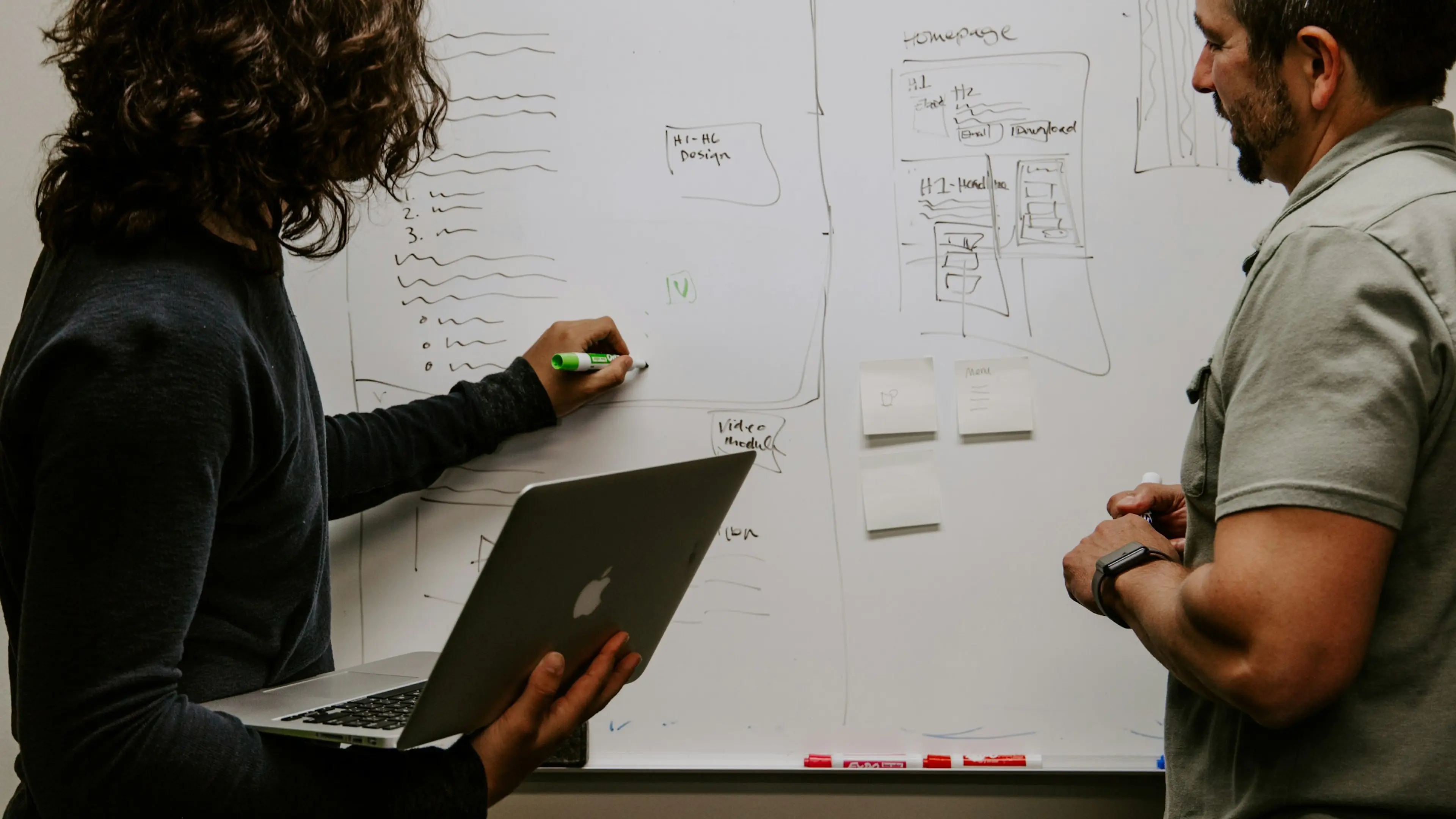28 January 2022 (updated: 8 February 2022)
How Much Does it Cost to Build an App in 2022?
Chapters

The simplest breakdown of what influences your app’s cost. And why.
How much does it cost to build an app in 2022? A very common question with no one straightforward answer. What you need to remember is that your app’s cost depends on numerous variables and also: there are important decisions you will need to make along the way.
The simplest example of this would be: hiring a freelance developer is probably much cheaper than hiring your team from an external agency. But bear in mind the consequences. A freelance developer might be cheaper, but they might not offer you quality assurance, maintenance, best practices of development, and project management like an established company with a wide portfolio would. And that’s just the first of the many variables to consider.
Dive in to learn what influences the cost of your app development in 2022.
Have your app’s priorities straight (and realistic)
You’re probably familiar with the project management triangle describing the biggest project management constraints: scope, budget, and time (you can find it described differently, e.g. good - fast - cheap, and in some other variations). But the main rule stays the same - they are all dependent on one another.
The quality of work delivered is constrained by the budget, deadlines, and features of your app. You can’t really have all three, you need to pick two and adjust them to your situation.
In a real-life example, it would look something like this: you have a set of features you would like to include in your app, a limited budget for development and a deadline for your MVP (Minimum Viable Product) to be released. In order to have satisfactory results, you’re probably faced with a decision to either cut the scope of your project (some of the features) to release the project sooner, increase the budget to engage more devs, or move the deadline to have enough time to finish — otherwise you’re going to end up with a poorly looking and not enough tested app that probably doesn’t meet either yours or your users’ expectations.
Have this in mind while talking to your prospective app development partner, and see what they offer you. If your app is extensive in features, and they offer to deliver it all a bit too quickly, it’s probably just too good to be true. In the world of software development, an experienced partner will never agree to deliver anything for unrealistic deadlines, and they will explicitly tell that to you, and explain why it is unrealistic.
Identify the app you're building
We already mentioned the app’s scope as one of the key project elements, but let’s specify it a bit more. In the simplest words, the app’s cost depends on its complexity, and by complexity we mean a couple of determining factors:
Platform
Are you building an app for just one platform (Desktop, Web, Android, or iOS) or all at the same time? What will be the technologies, e.g. in mobile development: native app development vs cross-platform app development. This business decision quite directly affects the ultimate cost of your app’s development.
For more context on native app development vs. cross-platform app development (e.g. React Native), check out these:
Features breakdown
Both, the number and velocity of your app’s features influence the app’s ultimate budget. Always try to define the features to build and make it as specific as you can. For example, app registration and login is a much broader term than you’d think. Don’t forget to include the variables you want to be included in the registration form and any side options such as sign-up via social media profiles or e-mail services, and password recovery.
Depending on the app type, the core features may differ. If you’re struggling with determining the priority or decision about a specific feature, you should always be able to consult your partner company for recommendations. Depending on the nature of the problem, they will be able to help you on the spot or help you organize a workshop to efficiently plan the development.
Resources for more context:
- See the case study of how we helped the client establish a viable scope of their MVP and split the product’s growth into actionable stages: Case study: Unlocking the power of a remote workshop
- Learn more about the benefits of a Product Design Workshop: Your product needs a Product Design Workshop to scale
One pro tip from an experienced software development partner would be this: at EL Passion, we always try to squeeze the initial app development into a maximum of 3 to 4 months. This is the optimal timeframe to launch a working product that is able to earn money for the client and offers just enough value for the end-user.
Not prolonging the launch for too long has many benefits for both: the client and the user. There might be some edge cases where this rule does not apply, but generally, the app release opens you to real-time user feedback, and then: building the product based on what your users need inside the app, and not just your predictions. In certain contexts, people will gladly offer you the help you need to enhance the app to their liking, and will participate in the user tests, feeling privileged they may experience version 1.0.
One more thing about the features: instead of covering all bases at the same time, and doing it superficially, it’s generally better to resolve one of your users' pain points and do it well. And build new features on top of that, rather than trying to have it all from the beginning. Digital product users are very much used to high quality, and it is one of the critical factors of an app’s later commercial success.
Design complexity
The design velocity and complexity of your app, similarly to features, affects your app’s cost, and sometimes not only on the design phase. If you need sophisticated animations for your app, this may also prolong the development, and hence, increase the cost of your app.
If you’re planning to scale your app over time, it’s good to consider building a design system, which is nothing else, but a collection of reusable components, guided by clear and understandable standards. Thanks to this, every designer working on enhancing the app further is aware of the guidelines guiding your app’s design, and your brand in general.
Backend infrastructure
Most apps nowadays need some kind of backend infrastructure to keep them going. Backend is responsible for storing, securing, and processing all data on the server side. The choice of the backend very much depends on the type of your app, the features, and the scaling plans you might have.
Security and data encryption
App security aims to prevent data or code within the app from being stolen or compromised. If you plan on storing sensitive data in your app (e.g. medical data, financial data), you need to take into account that developing and testing sophisticated security for your app might take longer than in simpler situations. Different types of app security may include authentication, authorization, encryption, and security testing. When your app connects to the cloud environment, it poses extra challenges from a security point of view, which you should also take into account.
App maintenance and further development plans
A digital product, even if it’s not further developed, needs to be maintained in order to work properly. Operating systems and security tools evolve dynamically, and the same goes for your app, even though the development might have already ended. Maintenance costs are usually about 20% of the cost of your app’s development.
Team size
How many developers do you need to develop an app? The team size of your development team is a result of your key development variables: the scope, the technology, the deadline, and your budget. E.g. hiring two developers will most likely increase the development speed, but it will definitely influence your budget, so it might not be an optimal solution for smaller projects.
This is why at EL Passion we came up with a setup to include a Junior Developer to every Senior developer working in a project. This state of affairs allows for better task management between the Senior and the Junior, and hence: better efficiency and faster story points delivery. In case of unpredictable events (your developer’s sickness or paid days off), the development can continue uninterrupted, no handover is required, as the knowledge about the project is not reliant on one person. All at a significantly lower cost than hiring two Mid or Senior developers.
The choice of a development partner: freelance vs agency
The first issue: do you think you need a freelancer or a software development company? Some of the benefits of hiring a freelancer would be: around 20-30% lower rates than software agencies, flexibility (as in most cases you pay only for the work done), they are relatively easy to find, and usually, they have solid experience in their specific area of expertise.
But hiring a freelancer comes with a set of risks. Freelance developers tend to work on multiple projects simultaneously, so a true iterative approach might be disrupted. The know-how is in the hands of one person, so in case of unpredictable events, the development might be prolonged, and, in case you decide to switch developers, the handover process takes significantly longer. It’s also not uncommon for freelance developers to drop the maintenance of an app on you. They will deliver version 1.0 of your app, but the later bug fixes and maintaining efforts are usually your problem.
Choosing a software development agency instead of a freelance developer might be pricier, but it covers (or should cover) all the aspects of software development: from research, business analysis or consulting, up to maintenance and enhancing the app. While working with an agency you can also expect them to develop the app to the highest standards of coding — pair programming, CI & CD (continuous integration & deployment). Their soft skills and self-organization skills are also vetted and tested, as they cooperate with one another, with Project Managers, and with clients on a daily basis.
The risk of resignation is much lower than in the case of hiring a freelancer, who can just resign from developing your app with no real consequences.
Agencies need a stable flow of business, so they take good care of their reputation and results, and they tend to be more accountable for their projects than individual developers. From the legal point of view, an agency will offer you transparency and reliability, as well as secrecy if you need it. Signing an NDA will most likely not be a problem. This might be different with a freelance developer.
The choice of methodology: Waterfall vs Agile
There are two most prominent methodologies in IT project management. The first one of them, Waterfall, focuses on collecting all project documentation and requirements upfront and then following those guidelines throughout the project. Even before the project start, your developers need to spend a considerable amount of time preparing the project’s detailed documentation. When the scope, all use cases, and acceptance criteria are thoroughly written down, designers and developers can start their work. This means spending 10-15% of your budget even before writing one line of code. Waterfall’s main benefit is that the budget can be very precisely estimated. The biggest risk? That there’s little room for changes throughout the project. Should anything change, you need to get back to square one and reestimate the project from scratch.
Waterfall seems easy on the outside, but taking into consideration the ever-changing nature of the software development world, it’s proven many times not to be an ideal way to develop an app. As mentioned earlier, changes are not easy in Waterfall, and the risks of its inflexibility can bring some projects down. Imagine you’re in the midst of developing your app, and the market situation changes or you get feedback from your users’ that it would be best to change one of the features and adjust it to your users’ needs. In Waterfall, you need to stick to the initial plan, so a reaction to a new market situation or users’ feedback may be hindered, and generally meets with a lot of paperwork, slowing down the development process significantly.
This is why many developers and software agencies prefer a more modern approach to development and IT project management — Agile project management.
In a nutshell, Agile is an iterative methodology, where instead of focusing on delivering the entire scope with “should haves” and “could haves” which takes a considerable amount of time before the product goes to market, the team focuses on a speed-to-market release of an MVP (Minimum Viable Product) and then builds on it by delivering tangible product value after each iteration. Thanks to breaking down the development plan into smaller chunks, it’s easier to change the priority or scope of specific project elements in real-time. Agile is said to be more based on the concepts of user and customer satisfaction, project quality, and the idea of constant improvement and constant delivery (known as CD & CI).
Some of the most prominent Agile risks stem more from the Agile principles’ misuse rather than Agile itself. On the client-side, it’s important to realize that as a product owner in Agile, you have the responsibility to check and test the functionalities your team builds, and to inform them about any disparities that might appear. Another important element to be mindful of is the scope creep risk. If a significant part of the scope changes during the development it can lead to shifting timelines, changing deliverables, and most importantly, the budget increase. This is, as mentioned before in the point about features breakdown, why at EL Passion we divide the project’s growth into tangible and realistic phases (e.g. MVP, 1.0, 1.1, etc), always bearing in mind the project value for the business and the end-user.
For more context see:
App development process - stages
Hiring a software development agency has its perks, one of them is the coverage of the app development process as a whole, as we mentioned above. But what are those app development stages you need to be mindful of?
Strategy
Strategy is the most crucial step of the app development process. Often overlooked, especially by first-timers, can be their first mistake. Strategy done well allows you to break down the app’s development into actionable stages of growth, limiting the scope creep risk, and allowing for a speed-to-market release of your app.
During the strategy phase, you can exercise your ideas freely and check the product’s potential with your prospective users to improve your market fit (research the competition, establish objectives, and your target group). This is also when you can decide on the best technology for your project and build your initial product backlog with the team.
TL;DR: a good strategy does not only improve the UX choices for your product, but it can also make the development process smoother, because of a well-thought-through backlog. For the best results, you should look for agencies offering comprehensive solutions, from strategy, through design, up to development. In the strategy phase, you should expect a UX designer, a developer, and sometimes, a business or Marketing specialist onboard.
Design
In the design phase, designers collect or clarify the project requirements for the best conceptual understanding of the app, and first create the app’s user flows and work through some of the edge cases that should be covered. After those are accepted and agreed on with the client, designers can continue on creating the UI screens, and, if need be: a style guide for the project.
Designers should work closely with developers and consult them about the doability of the design choices. The app’s design should not only be usable and appealing to the user, but also possible and practical to implement.
Development & Testing
In an Agile setting, after the project’s kick-off and establishing the backlog for the project’s development, developers usually work in 2-week iterations (sprints). As mentioned before, Agile allows for continuous value delivery, and a lot more flexibility should any project requirements change along the way.
Throughout the development process, you should not forget about testing, and quality assurance, which is most probably taken care of by your developers consistently throughout the process of the development.
Maintenance & Continuous delivery
Your product needs to be maintained after the initial launch. Even if your enhancement plans are pushed in time, you still need to take care of the app’s bug fixes, performance, licenses review, and customer feedback. Most agencies offer maintenance plans.
Summing up: questions to ask your software development partner
The app development process is by no means simple, but it can be clear, straightforward, and transparent with the right development partner, especially for software development first-timers out there.
There are many software development companies out there, so the mission to choose “the one” might be a bit overwhelming. Here are a couple of tips to know before choosing the right one for you.
- Browse their portfolio. Agencies often specialize or have great experience in building some types of apps, e.g. healthcare, finance, or other services. If you’re building something similar, and they have worked with some other companies from your domain industry, their experience might help your app in the long run.
- See the full scope of the services they offer. Check out their design skills, as well as their development tech stack. It’s also a good idea to ask whether they hire their developers in-house or if they just hire them for specific projects. Developers working in-house might have better communication skills, and they tend to care more about the project.
- Ask about project management, their best practices, and their way of work. Agile and Waterfall are project management frameworks, but just like everything else in this world, the execution & understanding of it might differ across different companies. You ought to know beforehand how the company you’re entrusting your app with, handles their day-to-day activities, plannings, risks, etc. You can also ask for a typical app timeline, and processes involved, what tools are used for communication, etc.
- Ask about your role and your level of involvement in the project. As we mentioned, in an Agile setting, you act as the project's Product Owner, and by definition, you need to be involved throughout the project. It's advised that your agency will clarify upfront the expected level of your involvement and feedback they need to keep the deliverables going.
Check out also
- 5 Tips for New & Non-technical Product Owners: A Product Owner’s non-technicality is not a problem. Their lack of product vision is. See 5 tips for starting Product Owners.
You may also like

Native vs Cross-Platform App Development: Which is Right for Your Business
3 September 2024 • Maria Pradiuszyk




